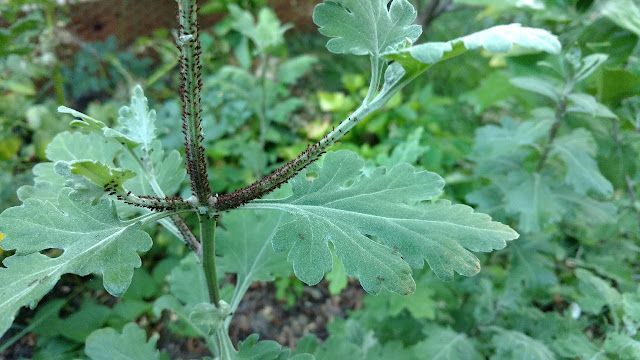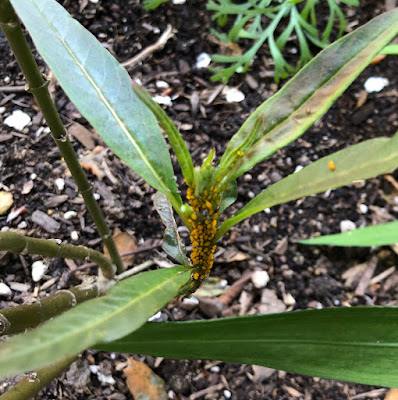
|
|
Look hard: Ants are on the leaves, carrying honeydew down to their nest. (Photo: Debbie Arrington)
|
Chrysanthemum aphids one of 5,000 species
One day, my mums were fine, growing happily and rapidly.
The next day I checked, the tips and upper stems were covered with tiny black bugs. The insects looked like aphids, but instead of the familiar lime green or light pink aphids that attack my roses and other plants, these were quite dark.
Also odd was their grouping; the bugs were lined up almost in straight rows.
Then, I noticed the ants – tiny little black ants that were moving up and down the mum stem. They were carrying something down from the rows of little bugs.
Like itsy bitsy dairy farmers, the ants were “milking” the critters for honeydew and carrying it back to their nest. The ants are how these bugs probably got there in the first place.
What to do? First, identify the invader. I turned to the best pest expert I know.
“Most likely this aphid is the chrysanthemum aphid but there are other aphids that also feed on mums,” said retired state entomologist Baldo Villegas, Sacramento’s Bug Man.
Aphids with an appetite for mums? Of course, they’re chrysanthemum aphids.
One of the most common summer pests in our gardens, aphids come in many, many variations, named for what they like to eat. At last count, there are about 5,000 species of aphids with at least 400 that attack food and fiber crops. Hundreds of others (such as the chrysanthemum aphid) go for ornamental plants.

|
|
Aphids come in all colors. Yellow-gold oleander aphids crowd
the stem of a milkweed plant. (Photo: Kathy Morrison)
|
The UC Integrated Pest Management website lists 1,430 articles on aphids. There’s advice for control of citrus aphids, peach aphids, bean aphids, cabbage aphids, corn aphids, potato aphids, walnut aphids and scads of other aphids.
“Almost every plant has one or more aphid species that occasionally feed on it,” say the UC experts. “Many aphid species are difficult to distinguish from one another; however, management of most aphid species is similar.”
Villegas shared advice on chrysanthemum aphids from Clemson University:
“Chrysanthemum aphids (
Macrosiphoniella sanborni
) and other aphid species are pests on chrysanthemums. The chrysanthemum aphids are brown to black, which other species range in color from green to pink. Aphids feed by piercing plant tissue and sucking plant sap. They prefer feeding on new growth in such areas as shoots, the undersides of leaves, buds and flowers. Their feeding can result in distorted growth, stunting and sometimes death of the entire plant.
“As they feed on plant sap, they excrete honeydew (a sugary material). The sooty mold fungus feeds on the honeydew, resulting in unsightly, dark fungal growth. In addition to damage caused by their feeding, chrysanthemum aphids can transmit various plant viruses.”
Whether aphids are eating mums, roses, beans or whatever, control methods are the same. Here are more Clemson tips:
“Aphids can be removed from plants by applying a forceful spray of water to the plants every two days, especially to the undersides of leaves. Continue as needed, but at least three times.
“Several naturally occurring enemies feed on aphids. As much as possible, these predators should be allowed to reduce aphid populations.
“As a result of their phenomenal ability to reproduce, aphids are very difficult to control with insecticides. Leaving one aphid alive can result in the production of a new colony very quickly. In addition, the use of insecticides kills the beneficial insects that normally keep aphid populations under control.”
If natural predators do not keep aphids under control and serious damage is occurring, spray plant with insecticidal soap or horticultural oil, Clemson recommends. Follow label directions.
Since discovering this outbreak, I’ve been blasting the mums with the hose; the plants appreciate the extra water. The aphids? They can’t swim – and they don’t survive the fall.
As for the ants, I’m sure they’re looking for a new spot to set up their next dairy farm.
For more on aphids, check out the UC IPM main aphid page:
http://ipm.ucanr.edu/PMG/PESTNOTES/pn7404.html


